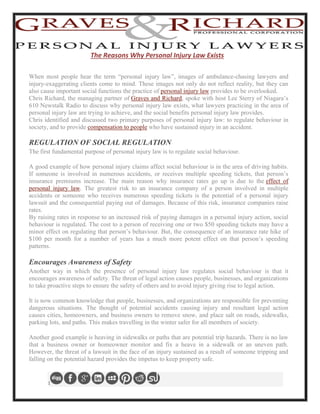The reasons why personal injury law exists
- 1. : The Reasons Why Personal Injury Law Exists When most people hear the term ŌĆ£personal injury lawŌĆØ, images of ambulance-chasing lawyers and injury-exaggerating clients come to mind. These images not only do not reflect reality, but they can also cause important social functions the practice of personal injury law provides to be overlooked. Chris Richard, the managing partner of Graves and Richard, spoke with host Lee Sterry of NiagaraŌĆÖs 610 Newstalk Radio to discuss why personal injury law exists, what lawyers practicing in the area of personal injury law are trying to achieve, and the social benefits personal injury law provides. Chris identified and discussed two primary purposes of personal injury law: to regulate behaviour in society, and to provide compensation to people who have sustained injury in an accident. REGULATION OF SOCIAL REGULATION The first fundamental purpose of personal injury law is to regulate social behaviour. A good example of how personal injury claims affect social behaviour is in the area of driving habits. If someone is involved in numerous accidents, or receives multiple speeding tickets, that personŌĆÖs insurance premiums increase. The main reason why insurance rates go up is due to the effect of personal injury law. The greatest risk to an insurance company of a person involved in multiple accidents or someone who receives numerous speeding tickets is the potential of a personal injury lawsuit and the consequential paying out of damages. Because of this risk, insurance companies raise rates. By raising rates in response to an increased risk of paying damages in a personal injury action, social behaviour is regulated. The cost to a person of receiving one or two $50 speeding tickets may have a minor effect on regulating that personŌĆÖs behaviour. But, the consequence of an insurance rate hike of $100 per month for a number of years has a much more potent effect on that personŌĆÖs speeding patterns. Encourages Awareness of Safety Another way in which the presence of personal injury law regulates social behaviour is that it encourages awareness of safety. The threat of legal action causes people, businesses, and organizations to take proactive steps to ensure the safety of others and to avoid injury giving rise to legal action. It is now common knowledge that people, businesses, and organizations are responsible for preventing dangerous situations. The thought of potential accidents causing injury and resultant legal action causes cities, homeowners, and business owners to remove snow, and place salt on roads, sidewalks, parking lots, and paths. This makes travelling in the winter safer for all members of society. Another good example is heaving in sidewalks or paths that are potential trip hazards. There is no law that a business owner or homeowner monitor and fix a heave in a sidewalk or an uneven path. However, the threat of a lawsuit in the face of an injury sustained as a result of someone tripping and falling on the potential hazard provides the impetus to keep property safe.
- 2. : The threat of personal injury lawsuits creates common sense safety standards for business owners and homeowners to follow. In grocery stores, for example, because of the multitude of personal injury lawsuits that result from customers slipping and falling on water spilt on the floor, most grocery stores have implemented inspection and prevention measures to avoid such incidents. Mats are installed at store entrances to collect water so that the floors inside stay dry, and attention is paid to choosing non- slip flooring. These measures are all taken for the purpose of creating a safe environment. The Balance Between Accident Prevention Measures and Personal Responsibility While the behaviour of people, businesses, and organizations is regulated by the threat of personal injury lawsuits, the law also imposes an obligation on every person to reasonably care for their own safety. In the case of a slipping hazard created by a heavy snow- and ice-storm, a known hazard exists. If the business- or home-owner does nothing about the hazard, liability may follow. By the same token, if a person sees the ice and is wearing high-heeled shoes with no tread, liability would likely attach to that person as well. In this case, a judge or a jury would balance the respective responsibilities for a resultant injury and apportion liability accordingly. COMPENSATION FOR INDIVIDUALS SUSTAINING INJURY The second fundamental purpose of personal injury law is to compensate individuals for the injuries they sustained as a result of an accident. Contrary to popular belief, damages awarded in personal injury actions are not ŌĆ£windfallsŌĆØ, but rather they are designed to compensate a person for injuries sustained and to restore them, as much as possible, to the position that person would have been in had the accident not occurred. If a person was rendered unable to work following an accident, that person is awarded a sum of money the equivalent to what that person would have earned had the accident not happened. Pain and suffering also is compensated by way of money. Chris shared that, in his experience, once jurors put the plaintiffŌĆÖs injuries in the context of that personŌĆÖs life, they donŌĆÖt view an award of damages as a windfall anymore, but rather they quickly begin considering the question of what an appropriate amount of money would be for someone who will never have the same quality of life again because of an accident. If the plaintiff is 40 year years old, was involved in an accident, was in good health before the accident, had neck pain following the accident, and was expected to have neck pain for the rest of her life, a sum of money compensating for that pain and suffering could be appropriately quite substantial. In summation, personal injury law regulates behaviour in society, encourages safety standards, and provides compensation to people who have sustained injury in an accident.


